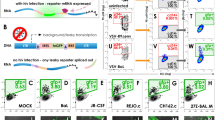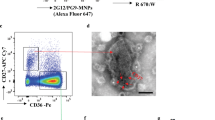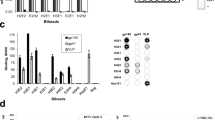Abstract
As an early event in the viral life cycle, the entry of enveloped viruses into target cells has received considerable attention. Viral fusion to cellular targets has been studied principally with fusion assays in which cells engineered to express the viral envelope are cultured with the target cells1,2. These assays yield valuable information but do not fully recapitulate all of the variables governing the fusion of actual virions to their cellular targets. The virion membrane and the plasma membrane, for example, differ strikingly in their lipid and protein compositions3,4,5. Two virion-based fusion assays have been described6,7,8. One is based on the redistribution of a self-quenching fluorophore6,7, whereas the second depends on photosensitized activation of a hydrophobic probe by a fluorescent lipid loaded into the target membrane8. These assays are complex and have not been adapted to study fusion in complex cell populations. We have developed a simple, rapid assay allowing the detection of HIV-1 virion fusion to biologically relevant target cells, including primary CD4+ T lymphocytes. It is based on the incorporation of β-lactamase–Vpr chimeric proteins (BlaM-Vpr) into HIV-1 virions and their subsequent delivery into the cytoplasm of target cells as a result of virion fusion. This transfer is then detected by enzymatic cleavage of the CCF2 dye, a fluorescent substrate of β-lactamase (BlaM), loaded in the target cells. BlaM cleaves the β-lactam ring in CCF2, changing its fluorescence emission spectrum from green (520 nm) to blue (447 nm) and thereby allowing fusion to be detected by fluorescence microscopy, flow cytometry, or UV photometry.
This is a preview of subscription content, access via your institution
Access options
Subscribe to this journal
Receive 12 print issues and online access
$209.00 per year
only $17.42 per issue
Buy this article
- Purchase on Springer Link
- Instant access to full article PDF
Prices may be subject to local taxes which are calculated during checkout



Similar content being viewed by others
References
Nussbaum, O., Broder, C.C. & Berger, E.A. Fusogenic mechanisms of enveloped-virus glycoproteins analyzed by a novel recombinant vaccinia virus-based assay quantitating cell fusion-dependent reporter gene activation. J. Virol. 68, 5411–5422 (1994).
Lineberger, J.E., Danzeisen, R., Hazuda, D.J., Simon, A.J. & Miller, M.D. Altering expression levels of human immunodeficiency virus type 1 gp120-gp41 affects efficiency but not kinetics of cell–cell fusion. J. Virol. 76, 3522–3533 (2002).
Nguyen, D.H. & Hildreth, J.E. Evidence for budding of human immunodeficiency virus type 1 selectively from glycolipid-enriched membrane lipid rafts. J. Virol. 74, 3264–3272 (2000).
Aloia, R.C., Tian, H. & Jensen, F.C. Lipid composition and fluidity of the human immunodeficiency virus envelope and host cell plasma membranes. Proc. Natl. Acad. Sci. USA 90, 5181–5185 (1993).
Tremblay, M.J., Fortin, J.F. & Cantin, R. The acquisition of host-encoded proteins by nascent HIV-1. Immunol. Today 19, 346–351 (1998).
Lowy, R.J., Sarkar, D.P., Chen, Y. & Blumenthal, R. Observation of single influenza virus-cell fusion and measurement by fluorescence video microscopy. Proc. Natl. Acad. Sci. USA 87, 1850–1854 (1990).
Chen, Y.D. & Blumenthal, R. On the use of self-quenching fluorophores in the study of membrane fusion kinetics. The effect of slow probe redistribution. Biophys. Chem. 34, 283–292 (1989).
Raviv, Y., Viard, M., Bess, J., Jr. & Blumenthal, R. Quantitative measurement of fusion of HIV-1 and SIV with cultured cells using photosensitized labeling. Virology 293, 243–251 (2002).
Bridger, G.J. et al. Synthesis and structure–activity relationships of phenylenebis(methylene)-linked bis-tetraazamacrocycles that inhibit HIV replication. Effects of macrocyclic ring size and substituents on the aromatic linker. J. Med. Chem. 38, 366–378 (1995).
Schols, D. et al. Inhibition of T-tropic HIV strains by selective antagonization of the chemokine receptor CXCR4. J. Exp. Med. 186, 1383–1388 (1997).
Marechal, V., Clavel, F., Heard, J.M. & Schwartz, O. Cytosolic Gag p24 as an index of productive entry of human immunodeficiency virus type 1. J. Virol. 72, 2208–2212 (1998).
Schaeffer, E., Geleziunas, R. & Greene, W.C. Human immunodeficiency virus type 1 Nef functions at the level of virus entry by enhancing cytoplasmic delivery of virions. J. Virol. 75, 2993–3000 (2001).
Baba, M. et al. A small-molecule, nonpeptide CCR5 antagonist with highly potent and selective anti-HIV-1 activity. Proc. Natl. Acad. Sci. USA 96, 5698–5703 (1999).
Eckstein, D.A. et al. HIV-1 actively replicates in naive CD4(+) T cells residing within human lymphoid tissues. Immunity 15, 671–682 (2001).
de Noronha, C.M. et al. Dynamic disruptions in nuclear envelope architecture and integrity induced by HIV-1 Vpr. Science 294, 1105–1108 (2001).
Zlokarnik, G. et al. Quantitation of transcription and clonal selection of single living cells with β-lactamase as reporter. Science 279, 84–88 (1998).
Acknowledgements
We thank Dominique Schols for the gift of AMD3100, Michael Miller for informal discussions, Marty Bigos for expertise in the flow cytometry–based experiments, Stephen Ordway and Gary Howard for editorial assistance, and John C.W. Carroll for graphic arts. W.C.G. thanks the J. David Gladstone Institutes, National Institutes of Health (P01 HD40543), the University-wide AIDS Research Program (C99-SF-02), and the James B. Pendleton Charitable Trust for funding support.
Author information
Authors and Affiliations
Corresponding author
Ethics declarations
Competing interests
The authors declare no competing financial interests.
Supplementary information
Rights and permissions
About this article
Cite this article
Cavrois, M., de Noronha, C. & Greene, W. A sensitive and specific enzyme-based assay detecting HIV-1 virion fusion in primary T lymphocytes. Nat Biotechnol 20, 1151–1154 (2002). https://doi.org/10.1038/nbt745
Received:
Accepted:
Published:
Issue Date:
DOI: https://doi.org/10.1038/nbt745
This article is cited by
-
Rapid, efficient and activation-neutral gene editing of polyclonal primary human resting CD4+ T cells allows complex functional analyses
Nature Methods (2022)
-
Low CCR5 expression protects HIV-specific CD4+ T cells of elite controllers from viral entry
Nature Communications (2022)
-
Herpesviruses assimilate kinesin to produce motorized viral particles
Nature (2021)
-
IFITM proteins promote SARS-CoV-2 infection and are targets for virus inhibition in vitro
Nature Communications (2021)
-
Human FCHO1 deficiency reveals role for clathrin-mediated endocytosis in development and function of T cells
Nature Communications (2020)



